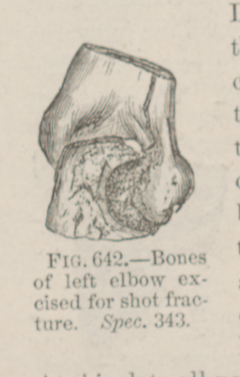Title: McAtee, A. M.
Source text: The Medical and Surgical History of the War of the Rebellion. (1861-65.), Part 2, Volume 2 (Washington, DC: Government Printing Office, 1876), 886.
Civil War Washington ID: med.d2e30991
TEI/XML: med.d2e30991.xml
CASE 1821.—Private A. M. McAtee, Co. F, 23d Ohio, aged 20 years, was wounded in the left elbow, at Antietam, Maryland, September 17, 1862. Five days afterward he was admitted to Mount Pleasant Hospital, Washington, where Assistant Surgeon C. A. McCall, U. S. A., excised the injured joint on October 21st. The patient recovered, and was discharged from service, December 30, 1862, and pensioned. The specimen, represented in the wood-cut (FIG. 642), was contributed by the operator, and consists of two inches of the extremity of the humerus, and the ulna removed just below the coronoid process, the olecranon being fractured, and a vertical fracture extending through the middle of the trochlea. The articular surface is partly eroded. An account of this case was published by Dr. McCall in the Medical and Surgical Reporter, Vol. IX, 1862-63, p. 231, as follows: "Gunshot wound of elbow joint, causing compound comminuted fracture of olecranon, of condyle of humerus, and of the shaft of the latter bone for some distance above the articular head. About half the lower third of the humerus was removed, together with the olecranon and articular head of the ulna. The radius was left intact. The arm was put upon a straight splint, with simple absorbent dressings to parts. Tonics and stimulants. The straight splint was exchanged for an angular pasteboard one about November 1st, the forearm being semi-flexed upon the arm. No untoward symptoms occurred; the wound healed well, and ceased discharging the first week in December. At this date all pain and most of the swelling had disappeared. The fingers could be moved slightly, but the arm had no power to support itself without the splint. The mobility of the joint was considerable: the arm could be moved, without cruising pain or inconvenience, from a nearly straight to a semi-flexed condition." Examiner W. D. Scarff, of Bellefontaine, Ohio, certified, on the following respective dates: April 4, 1863: "The ball seems to have passed longitudinally through the joint, thereby destroying the joint and rendering the arm useless." February 16, 1864: "The wound has healed entire, but the forearm hangs just as an appendage and is an encumbrance, of no use to him." November 11, 1866: "The injury is fully equal to the loss of the forearm." September 4, 1873: "The muscles are all shrunken, and the entire arm is more of an encumbrance than otherwise." The pensioner was paid September 4, 1875.
